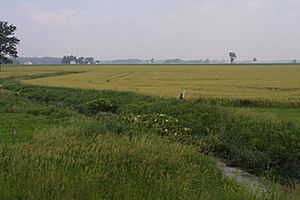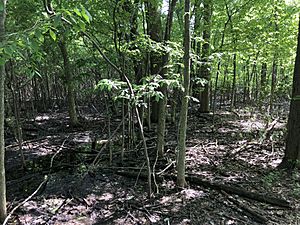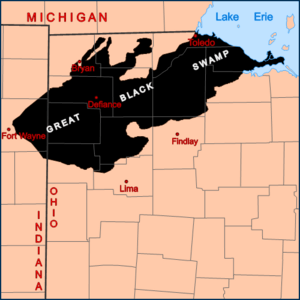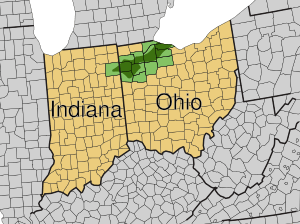Great Black Swamp facts for kids

The Great Black Swamp was a huge, wet area that covered parts of northwest Ohio, southern Michigan, and northeast Indiana. It was formed by melting glaciers after the last Ice Age, called the Wisconsin glaciation. This swamp existed until the late 1800s.
It was a mix of swamps and marshes, with some drier spots. This area used to be the southwestern part of an ancient lake called Lake Maumee, which came before Lake Erie. The swamp was about 25 miles (40 km) wide and 100 miles (160 km) long. It covered roughly 1,500 square miles (4,000 km2).
Today, this land is mostly very good farmland. But draining the swamp has caused problems for the environment. Water running off farms carries pollution into Lake Erie. This pollution causes harmful algal blooms to grow often in the lake.
The land that was once the swamp is mainly in the Maumee River and Portage River areas. These rivers collect water from the land around them. The swamp's edges were sandy ridges. These ridges were old beaches from Lakes Maumee and Whittlesey, which formed after the glaciers melted.
The swamp stretched from Fort Wayne, Indiana, to the Ottawa National Wildlife Refuge near Port Clinton, Ohio. It also went from about US 6 south to Findlay. Traveling through the swamp was very hard, especially in wet seasons. People thought it was too difficult for anyone but adult men.
The Great Black Swamp was a mix of forests, wetlands, and grasslands. In the lowest, wettest spots, there were swamp forests. These had trees like ash, elm, cottonwood, and sycamore. In slightly higher, better-drained areas, you would find beech, maples, basswood, and tuliptrees. On the dry, sandy ridges, there were oak and hickory trees. The area also had open wetlands, like marshes and wet prairies. Marshes were very common along the Lake Erie shoreline.
Why the Swamp Was Drained
Most areas around the swamp were settled in the early 1800s. But the thick forests and tough travel made it hard to develop the swamp itself. A special road, called a corduroy road, was built in 1825. It went from modern-day Fremont, Ohio to Perrysburg, Ohio. Even with this road, travel could take days or weeks during wet times.
The swamp was so hard to cross that it even stopped a small conflict. This was the Toledo War (1835–36), a border dispute between Michigan and Ohio. Because they couldn't get through the swamp, the armies never actually fought. People living in the swamp also got sick often from a disease called malaria. This problem stopped once the swamp was drained and the places where mosquitoes bred dried up.
In the 1850s, the states started to drain the swamp on purpose. They wanted to use the land for farming and make travel easier. Many projects were started over 40 years. A person from Bowling Green, Ohio, named James B. Hill, helped a lot. His machine, the Buckeye Traction Ditcher, laid drainage tiles very quickly.
Most of the swamp was drained and settled over the next 30 years. The growth of railroads and a local industry that made drainage tiles helped a lot with this process.
Bringing the Swamp Back

In the second half of the 1900s, people started trying to save and bring back parts of the swamp. One example is the Limberlost Swamp. Since 2011, harmful algal blooms have become a big problem in western Lake Erie every year. This has made people more interested in bringing back wetlands in the old Black Swamp area.
Experts like William J. Mitsch (in 2017) suggested bringing back or creating 150 square miles (400 km2) of wetlands. This would be about 10% of the original swamp. These wetlands would help greatly reduce the pollution flowing from the Maumee River into Lake Erie.
The Black Swamp Conservancy, started in 1993, also works to protect old swamp lands. They currently protect 17,600 acres across northwest Ohio.
Images for kids
-
View from a ridge near Benton Ridge, Ohio, which demarks the edge of the former Great Black Swamp.
-
A restored swamp section in Bowling Green, Ohio.







